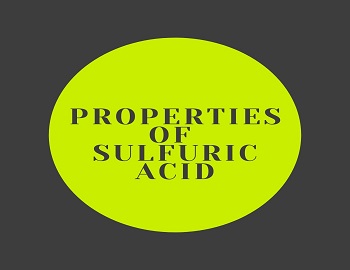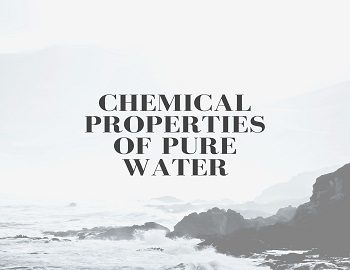Table of Contents
Properties of Sulfuric Acid:
Physical Properties of Sulfuric Acid:
- Sulfuric acid is a thick colourless syrupy liquid and has no odour.
- Its density is 1.84. Its melting point and boiling point are 10.38°C and 338°C respectively.
- It does not fume in air and has no sour taste.
- It is corrosive to skin.
- Pure anhydrous acid is a bad conductor of heat and electricity. Aqueous solution of the acid, however, conducts electric current.
- It dissolves in water in all proportions. When concentrated acid is added to water, a considerbale amount of heat is evolved. Always pour acid into water and never water to the acid.
Chemical Properties of Sulfuric Acid:
Chemically, sulfuric acid is an important reactive compound.
(1) Action of Heat- On heating strongly, it undergoes dissociation at 440°C to yield water and sulfur trioxide.
| H2SO4 ⇌ H2O + SO3 |
When vapours of acid are passed through a red hot silica tube, it decomposes to give SO2, oxygen and water.
| 2H2SO4 ———-> 2H2O + 2SO2 + O2 |
(2) Acidic Properties- Sulfuric acid is a strong dibasic acid and it ionizes in water as-
| H2SO4 + H2O ———-> H3O+ + HSO4– HSO4– + H2O ———-> H3O+ + SO4– |
Due to the formation of hydronium ions, an aqueous solution of sulfuric acid behaves as an acid.
The acidic nature of the aqueous solution of acid is supported as under-
(a) Action of blue litmus paper- It turns blue litmus paper red.
(b) Action of alkalis- It neutralizes alkalis like NaOH to give the acid and normal slats.
| NaOH + H2SO4 ———-> H2O + NaHSO4 (Acid Salt) 2NaOH + H2SO4 ———-> 2H2O + Na2SO4 (Normal Salt) |
(c) Action of carbonates- It decomposes carbonates like Na2CO3 forming the corresponding sulfate and carbon dioxide.
| Na2CO3 + H2SO4 ———-> Na2SO4 + CO2 + H2O |
(d) Action of basic oxides- It reacts with basic oxides such as CaO to form the corresponding salt and water.
| CaO + H2SO4 ———-> CaSO4 + H2O |
(e) Action of ammonia- It combines with ammonia to give ammonium sulfate.
| 2NH3 + H2SO4 ———-> (NH4)2SO4 |
(f) Action of metals- Dilute H2SO4 reacts with metals like Zn, Fe etc. to give the corresponding salt and hydrogen.
| Zn + H2SO4 ———-> ZnSO4 + H2 Mg + H2SO4 ———-> MgSO4 + H2 |
(g) Action of bicarbonates- It decomposes bicarbonates like NaHCO3 to give carbon dioxide.
| 2NaHCO3 + H2SO4 ———-> Na2SO4 + 2H2O + CO2 |
(3) Dehydrating Properties- Concentrated sulfuric acid is a strong dehydrating agent. It removes even the combined hydrogen and oxygen from certain organic compounds giving rise to the formation of hydrates of the type (H2SO4, H2O), (H2SO4, 2H2O) etc.
(a) Action of formic acid- It dehydrates formic acid to carbon monoxide.
| HCOOH + H2SO4 ———-> CO + (H2SO4, H2O) |
(b) Action of oxalic acid- Oxalic acid is dehydrated to give carbon monoxide and carbon dioxide.
| COOH-COOH + H2SO4 ———-> CO + CO2 + (H2SO4, H2O) |
(c) Action of sugar- It reacts with sugar to produce charring indicating the formation of carbon.
| C12H22O11 + H2SO4 ———-> 12C (Sugar Charcoal) + (H2SO4, 11H2O) |
(d) Action of copper sulfate crystals- On this treatment, the blue crystals of copper sulfate turn white owing to the removal of four molecules of water of crystallization.
| CuSO4.5H2O (Blue Colour) ———-> CuSO4.H2O (White) + (H2SO4, 4H2O) |
(4) Oxidizing Properties- Dilute H2SO4 has no oxidizing action but hot concentrated H2SO4 acts as a powerful oxidizing agent. Concentrated acid decomposes to give nascent oxygen.
| H2SO4 ———-> H2O + SO2 + (O) |
Some typical oxidizing reactions of sulfuric acid are-
(a) Action of non-metals- Concentrated H2SO4 oxidizes certain non-metals like carbon, sulfur and phosphorous.
- Action of Carbon- It oxidizes carbon to carbon dioxide.
| C + 2H2SO4 ———-> 2H2O + 2SO2 + CO2 |
- Action of sulfur- It oxidizes sulfur to sulfur dioxide.
| S + 2H2SO4 ———-> 2H2O + 3SO2 |
- Action of phosphorous- Phosphoric acid is obtained in this case.
| P4 + 10H2SO4 ———-> 4H3PO4 + 4H2O + 10SO2 |
(b) Action of metals- Hot concentrated H2SO4 reacts with a number of metals like copper, lead, zinc etc. to give rise to the formation of corresponding salts and sulfur dioxide.
| Cu + 2H2SO4 ———-> CuSO4 + 2H2O + SO2 Zn + 2H2SO4 ———-> ZnSO4 + 2H2O + SO2 |
(c) Action of compounds of non-metals- Concentrated H2SO4 oxidizes compounds like hydrogen sulfide and halogens acids to the corresponding products.
(a) Action of hydrogen sulfide- It oxidizes H2S to sulfur.
| H2S + H2SO4 ———-> 2H2O + SO2 + S |
(b) Action of hydrobromic acid- It is oxidized to bromine.
| 2HBr + H2SO4 ———-> 2H2O + SO2 + Br2 |
Similarly, hydroiodic acid is oxidized to iodine.
(5) Action of Salts- Sulfuric acid is less volatile than other acids such as HCl, HNO3, etc. and reacts with the salts of more volatile acids to give rise to the formation of the corresponding acids.
(a) Treatment with dilute H2SO4– Dilute H2SO4 reacts with salts such as Na2S, Na2SO3, KNO2 etc. to form the corresponding products.
| Na2S + H2SO4 ———-> Na2SO4 + H2S Na2SO3 + H2SO4 ———-> Na2SO4 + SO2+ H2O 2KNO2 + H2SO4 ———-> k2SO4 + H2O + NO + NO2 |
(b) Treatment with concentrated H2SO4– Concentrated H2SO4 reacts with salts like NaCl, CH3COONa and Na2C2O4 to form the corresponding acids.
| NaCl + H2SO4 ———-> NaHSO4 + HCl NaNO3 + H2SO4 ———-> NaHSO4 + HNO3 2CH3COONa + H2SO4 ———-> Na2SO4 + 2CH3COOH COONa-COONa + H2SO4 ———-> Na2SO4 + COOH-COOH |
(6) Action of sulfur trioxide- Sulfur trioxide dissolves in concentrated H2SO4 to give pyrosulfuric acid (oleum).
| SO3 + H2SO4 ———-> H2S2O7 (oleum) |
(7) Precipitation reactions- Sulfuric acid on treatment with soluble barium and lead salts solutions giving the precipitates of barium sulfate and lead sulfate.
| BaCl2 + H2SO4 ———-> BaSO4 + 2HCl Pb(NO3)2 + H2SO4 ———-> PbSO4 + 2HNO3 |









Comments (No)